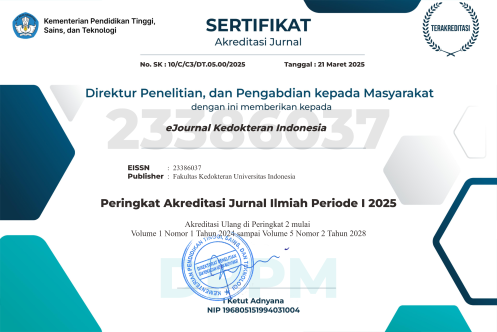Hubungan Faktor Sosiodemografis Korban Kekerasan Seksual Anak dengan Kedatangan ke Poliklinik Stres Pasca-trauma RSCM, 2017-2020
DOI:
https://doi.org/10.23886/ejki.10.162.121-8Keywords:
anak, kedatangan ke layanan kesehatan mental, kekerasan seksualAbstract
Kedatangan korban kekerasan seksual anak ke layanan kesehatan mental cukup rendah. Keputusan mengakses layanan kesehatan mental dipengaruhi faktor sosiodemografis. Penelitian bertujuan mendapatkan gambaran faktor sosiodemografis korban kekerasan seksual anak dan hubungannya dengan kedatangan ke Poliklinik Stres Pasca Trauma (PSPT) Anak dan Remaja RSCM setelah pemeriksaan awal di Pusat Krisis Terpadu (PKT) RSCM. Studi potong lintang ini melibatkan 90 pasien yang datang ke PKT RSCM pada bulan Februari 2017 – Desember 2020. Kedatangan ke PSPT ditelusuri dari electronic health record. Terdapat 20 sampel (22,22%) korban yang datang, sebagian besar berusia 12-18 tahun (55%), perempuan (95%), dan tidak memiliki riwayat gangguan mental (70%). Pelaku rawat sebagian besar berusia 39-48 tahun (50%), menikah (80%), karyawan swasta (70%), lulusan SMA/SMK (45%), tidak memiliki riwayat gangguan mental (85%), mempunyai ≥ 3 anak (45%), suku Jawa (35%), pendapatan ≥ Rp 4.597.078 (70%), dan menggunakan pembiayaan umum (65%). Riwayat gangguan mental pada anak (p<0,001) dan pelaku rawat (p=0,010) berhubungan dengan kedatangan ke PSPT. Disimpulkan faktor sosiodemografi, yaitu riwayat gangguan mental pada anak dan pelaku rawat berhubungan dengan kedatangan ke PSPT.
Kata kunci: anak, kedatangan ke layanan kesehatan mental, kekerasan seksual.
Child Sexual Abuse Victims Sociodemographic Profile Associated with Attendance to Post Traumatic Stress Recovery Outpatient Clinic Cipto Mangunkusumo Hospital: 2017-2020
Abstract
Child sexual abuse victim attendance to mental health services is quite low. Decision to access mental health services is influenced by sociodemographic factors. The aim of this study is to obtain child sexual abuse victim sociodemographic profile and their association with attendance to Cipto Mangunkusumo Hospital’s Child and Adolescent Post Traumatic Stress Recovery Outpatient Clinic after initial assessment in Cipto Mangunkusumo Hospital’s Integrated Crisis Center. This cross-sectional study involving 90 patients who came to Cipto Mangunkusumo Hospital’s Integrated Crisis Center in February 2017 – December 2020. Attendances to Cipto Mangunkusumo Hospital’s Post Traumatic Stress Recovery Outpatient Clinic were traced from electronic health record. There were 20 samples (22.22%) who came, majority were 12-18 years old (55%), female (95%), and did not have mental disorders (70%). Most of caregivers were 39-48 years old (50%), married (80%), private employees (70%), high school graduate (45%), do not have mental disorders (85%), have ≥ 3 children (45%), Javanese (35%), income > IDR 4,597,078 (70%), and use out of pocket financing (65%). Mental disorders history in children (p<0,001) and caregivers (p=0.010) had a significant relationship with attendance at Cipto Mangunkusumo Hospital’s Child and Adolescent Post Traumatic Stress Recovery Outpatient Clinic. Concluded that sociodemographic factor, that is mental disorders history in children and caregivers had association with attendance to Cipto Mangunkusumo Hospital’s Child and Adolescent Post Traumatic Stress Recovery Outpatient Clinic.
Keywords: attendance to mental health services, children, sexual abuse.
Downloads
Downloads
Published
How to Cite
Issue
Section
License
Copyright (c) 2022 Andika Widianti, Fransiska Kaligis, Tjhin Wiguna, Raden Irawati Ismail

This work is licensed under a Creative Commons Attribution-NonCommercial 4.0 International License.
Accepted 2022-08-31
Published 2022-09-07



